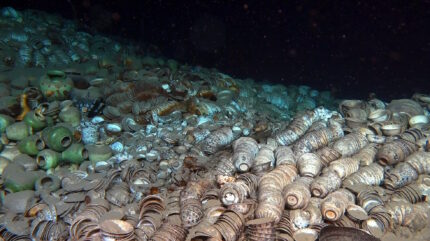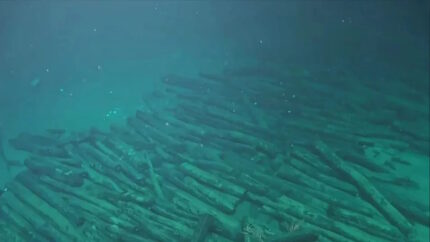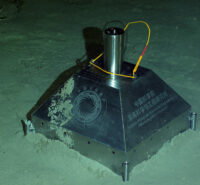Two shipwrecks from the Ming Dynasty (1368-1644), one laden with thousands of pristine porcelain objects, the other with wood logs, have been discovered deep under the South China Sea. The shipwrecks were discovered last October on the northwest continental slope of the South China Sea off the coast of Hainan island at a depth of 1,500 meters (just under a mile).
 With the wreck of Ship No. 1, the remains of the ship itself are mostly obscured by tens of thousands of porcelain artifacts intended for export trade. The porcelain is so dense that there are stacked and nested vessels six feet deep covering 10,000 square meters (2.5 acres). Archaeologists estimate there are more than 100,000 individual pieces. Analysis of a few of the pieces suggest they were produced during the Zhentoku era (1506-1521).
With the wreck of Ship No. 1, the remains of the ship itself are mostly obscured by tens of thousands of porcelain artifacts intended for export trade. The porcelain is so dense that there are stacked and nested vessels six feet deep covering 10,000 square meters (2.5 acres). Archaeologists estimate there are more than 100,000 individual pieces. Analysis of a few of the pieces suggest they were produced during the Zhentoku era (1506-1521).
 Ship No. 2 was carrying raw wood. The timbers were uniform in size and carefully stacked. Initial analysis of the wood indicates the ship was a Chinese importer bringing in wood supplies from overseas in the Meiji-Koji era (1488-1505). They were likely intended for use in ship-building.
Ship No. 2 was carrying raw wood. The timbers were uniform in size and carefully stacked. Initial analysis of the wood indicates the ship was a Chinese importer bringing in wood supplies from overseas in the Meiji-Koji era (1488-1505). They were likely intended for use in ship-building.
This is the first time a ship with export cargo and one with import cargo have been found in the same area. It is evidence of how well-established and widely-frequented in both directions sea routes were along the Maritime Silk Road. The two neighboring wrecks provide researchers a unique opportunity to study two-way traffic in the South China Sea 500 years ago.
 Underwater archaeology in such deep waters poses enormous logistical challenges. This month, the cultural heritage administration of Hainan Province launched a new investigation to map the shipwrecks using a state-of-the-art manned submersible and a new permanent surveying and mapping base point installed in the seabed at the wreck of the first ship. This marks a significant leap forward in deep-sea archaeology.
Underwater archaeology in such deep waters poses enormous logistical challenges. This month, the cultural heritage administration of Hainan Province launched a new investigation to map the shipwrecks using a state-of-the-art manned submersible and a new permanent surveying and mapping base point installed in the seabed at the wreck of the first ship. This marks a significant leap forward in deep-sea archaeology.
China’s scientific research vessel Tansuo 1, equipped with the submersible Shenhai Yongshi, or Deep Sea Warrior, took researchers underwater for the exploration on Saturday. Chen Chuanxu, a scientist at the Institute of Deep-sea Science and Engineering, said that another vessel, the Tansuo 2, equipped with the submersible Fendouzhe, or Striver, will join the mission.
Advanced technological approaches, including soft robotics inspired by bionics and material science, were employed during the operation to salvage some of the relics from the shipwreck sites. New methods of scanning, photography and monitoring were also used.
“Speaking of protection and real-time monitoring of such a large underwater site at a depth of 1,500 meters, we have no precedent in the world,” Chen said, adding that the researchers are currently trying to remotely monitor the site.
The investigation will take place over about a year. The first phase will be a thorough survey of the wrecks. The second will entail a scientific evaluation of the preservation conditions of the wrecks. The third and final phase will be determining how best to protect the wrecks going forward.